Dosing & Uses
Dosage Forms & Strengths
injectable IV solution (ready-to-use)
- 0.1 mg/mL (Biorphen)
- Do not dilute further
injectable IV solution (concentrated)
- 10mg/mL (Vazculep, Biorphen)
- Requires further dilution
Severe Hypotension/Shock
Alpha-1 adrenergic receptor agonist indicated for treatment of clinically important hypotension resulting primarily from vasodilation in the setting of anesthesia
IV bolus: 40-100 mcg q1-2 min PRN, not to exceed total dose of 200 mcg
Adjust dosage according to blood pressure goal
Continuous IV infusion: If blood pressure is below the target goal, start a continuous IV infusion with an infusion rate of 10-35 mcg/min; not to exceed 200 mcg/min
Dosage Modifications
Renal impairment
- Mild-to-moderate: Consider starting at the lower end of the recommended dose range, and adjusting dose based on the target blood pressure goal
- End-stage renal disease (ESRD): Dose-response data indicate increased responsiveness to phenylephrine
Hepatic impairment
- Start dosing in the recommended dose range, but more phenylephrine may be needed in this population
- Moderate-to-severe (Child-Pugh Class B or C): Dose-response data indicate decreased responsiveness to phenylephrine
Dosing considerations
Drug not recommended by The Society of Critical Care Medicine, to treat septic shock, except when first line agent epinephrine associated with causing serious arrhythmia, when cardiac output is high and blood pressure persistently low, or when combination of inotrope/vasopressor and low dose vasopressin failed to achieve desired mean arterial pressure and phenylephrine used as salvage therapy
Dosage Forms & Strengths
injectable IV solution (ready-to-use)
- 0.1 mg/mL (Biorphen)
- Do not dilute further
injectable IV solution (concentrated)
- 10mg/mL (Vazculep, Biorphen)
- Requires further dilution
Severe Hypotension/Shock (Off-label)
<2 years
- Safety and efficacy not established
≥2 years
Interactions
Interaction Checker
No Results

Contraindicated
Serious - Use Alternative
Significant - Monitor Closely
Minor

Contraindicated (7)
- iobenguane I 123
phenylephrine decreases effects of iobenguane I 123 by receptor binding competition. Contraindicated. If clinically appropriate, discontinue drugs that compete for NE receptor sites for at least 5 half-lives; may cause false-negative imaging results.
- isocarboxazid
isocarboxazid increases effects of phenylephrine by pharmacodynamic synergism. Contraindicated. Risk of acute hypertensive episode.
- linezolid
linezolid increases effects of phenylephrine by pharmacodynamic synergism. Contraindicated. Risk of acute hypertensive episode.
- phenelzine
phenelzine increases effects of phenylephrine by pharmacodynamic synergism. Contraindicated. Risk of acute hypertensive episode.
- procarbazine
procarbazine increases effects of phenylephrine by pharmacodynamic synergism. Contraindicated. Risk of acute hypertensive episode.
- selegiline transdermal
selegiline transdermal increases effects of phenylephrine by pharmacodynamic synergism. Contraindicated. Risk of acute hypertensive episode.
- tranylcypromine
tranylcypromine increases effects of phenylephrine by pharmacodynamic synergism. Contraindicated. Risk of acute hypertensive episode.
Serious - Use Alternative (27)
- amitriptyline
amitriptyline, phenylephrine. Other (see comment). Avoid or Use Alternate Drug. Comment: Tricyclic antidepressants increase or decrease effects of sympathomimetics, by blocking reuptake of NE, or blocking uptake of indirect sympathomimetics into the adrenergic neuron.
- amoxapine
amoxapine, phenylephrine. Other (see comment). Avoid or Use Alternate Drug. Comment: Tricyclic antidepressants increase or decrease effects of sympathomimetics, by blocking reuptake of NE, or blocking uptake of indirect sympathomimetics into the adrenergic neuron.
- cabergoline
cabergoline, phenylephrine. Mechanism: pharmacodynamic synergism. Contraindicated. Additive vasospasm; risk of hypertension.
- clomipramine
clomipramine, phenylephrine. Other (see comment). Avoid or Use Alternate Drug. Comment: Tricyclic antidepressants increase or decrease effects of sympathomimetics, by blocking reuptake of NE, or blocking uptake of indirect sympathomimetics into the adrenergic neuron.
- desflurane
desflurane increases toxicity of phenylephrine by Mechanism: unknown. Avoid or Use Alternate Drug. Risk of V tach, HTN.
desflurane increases levels of phenylephrine by decreasing metabolism. Contraindicated. - desipramine
desipramine, phenylephrine. Other (see comment). Avoid or Use Alternate Drug. Comment: Tricyclic antidepressants increase or decrease effects of sympathomimetics, by blocking reuptake of NE, or blocking uptake of indirect sympathomimetics into the adrenergic neuron.
- dihydroergotamine
dihydroergotamine, phenylephrine. Mechanism: pharmacodynamic synergism. Contraindicated. Additive vasospasm; risk of hypertension.
- dihydroergotamine intranasal
dihydroergotamine intranasal, phenylephrine. Mechanism: pharmacodynamic synergism. Contraindicated. Additive vasospasm; risk of hypertension.
- doxapram
doxapram increases effects of phenylephrine by pharmacodynamic synergism. Avoid or Use Alternate Drug. Additive pressor effect.
- doxepin
doxepin, phenylephrine. Other (see comment). Avoid or Use Alternate Drug. Comment: Tricyclic antidepressants increase or decrease effects of sympathomimetics, by blocking reuptake of NE, or blocking uptake of indirect sympathomimetics into the adrenergic neuron.
- ergoloid mesylates
ergoloid mesylates, phenylephrine. Mechanism: pharmacodynamic synergism. Contraindicated. Additive vasospasm; risk of hypertension.
- ergotamine
ergotamine, phenylephrine. Mechanism: pharmacodynamic synergism. Contraindicated. Additive vasospasm; risk of hypertension.
- ether
ether increases toxicity of phenylephrine by Mechanism: unknown. Avoid or Use Alternate Drug. Risk of V tach, HTN.
- etomidate
etomidate increases levels of phenylephrine by decreasing metabolism. Contraindicated.
- imipramine
imipramine, phenylephrine. Other (see comment). Avoid or Use Alternate Drug. Comment: Tricyclic antidepressants increase or decrease effects of sympathomimetics, by blocking reuptake of NE, or blocking uptake of indirect sympathomimetics into the adrenergic neuron.
- isoflurane
isoflurane increases toxicity of phenylephrine by Mechanism: unknown. Avoid or Use Alternate Drug. Risk of V tach, HTN.
- lofepramine
lofepramine, phenylephrine. Other (see comment). Avoid or Use Alternate Drug. Comment: Tricyclic antidepressants increase or decrease effects of sympathomimetics, by blocking reuptake of NE, or blocking uptake of indirect sympathomimetics into the adrenergic neuron.
- maprotiline
maprotiline, phenylephrine. Other (see comment). Avoid or Use Alternate Drug. Comment: Tricyclic antidepressants increase or decrease effects of sympathomimetics, by blocking reuptake of NE, or blocking uptake of indirect sympathomimetics into the adrenergic neuron.
- methoxyflurane
methoxyflurane increases toxicity of phenylephrine by Mechanism: unknown. Avoid or Use Alternate Drug. Risk of V tach, HTN.
- methylergonovine
methylergonovine, phenylephrine. Mechanism: pharmacodynamic synergism. Contraindicated. Additive vasospasm; risk of hypertension.
- nortriptyline
nortriptyline, phenylephrine. Other (see comment). Avoid or Use Alternate Drug. Comment: Tricyclic antidepressants increase or decrease effects of sympathomimetics, by blocking reuptake of NE, or blocking uptake of indirect sympathomimetics into the adrenergic neuron.
- propofol
propofol increases levels of phenylephrine by decreasing metabolism. Contraindicated.
- protriptyline
protriptyline, phenylephrine. Other (see comment). Avoid or Use Alternate Drug. Comment: Tricyclic antidepressants increase or decrease effects of sympathomimetics, by blocking reuptake of NE, or blocking uptake of indirect sympathomimetics into the adrenergic neuron.
- sevoflurane
sevoflurane increases toxicity of phenylephrine by Mechanism: unknown. Avoid or Use Alternate Drug. Risk of V tach, HTN.
sevoflurane increases levels of phenylephrine by decreasing metabolism. Contraindicated. - trazodone
trazodone, phenylephrine. Other (see comment). Avoid or Use Alternate Drug. Comment: Tricyclic antidepressants increase or decrease effects of sympathomimetics, by blocking reuptake of NE, or blocking uptake of indirect sympathomimetics into the adrenergic neuron.
- trimipramine
trimipramine, phenylephrine. Other (see comment). Avoid or Use Alternate Drug. Comment: Tricyclic antidepressants increase or decrease effects of sympathomimetics, by blocking reuptake of NE, or blocking uptake of indirect sympathomimetics into the adrenergic neuron.
- yohimbe
yohimbe, phenylephrine. Mechanism: pharmacodynamic synergism. Contraindicated. Risk of acute hypertensive episode.
Monitor Closely (169)
- albuterol
albuterol and phenylephrine both decrease sedation. Use Caution/Monitor.
albuterol and phenylephrine both increase sympathetic (adrenergic) effects, including increased blood pressure and heart rate. Use Caution/Monitor. - alfentanil
alfentanil increases and phenylephrine decreases sedation. Effect of interaction is not clear, use caution. Use Caution/Monitor.
- alprazolam
alprazolam increases and phenylephrine decreases sedation. Effect of interaction is not clear, use caution. Use Caution/Monitor.
- amitriptyline
amitriptyline increases and phenylephrine decreases sedation. Effect of interaction is not clear, use caution. Use Caution/Monitor.
- amobarbital
amobarbital increases and phenylephrine decreases sedation. Effect of interaction is not clear, use caution. Use Caution/Monitor.
- amoxapine
amoxapine increases and phenylephrine decreases sedation. Effect of interaction is not clear, use caution. Use Caution/Monitor.
- arformoterol
arformoterol and phenylephrine both decrease sedation. Use Caution/Monitor.
arformoterol and phenylephrine both increase sympathetic (adrenergic) effects, including increased blood pressure and heart rate. Use Caution/Monitor. - aripiprazole
aripiprazole increases and phenylephrine decreases sedation. Effect of interaction is not clear, use caution. Use Caution/Monitor.
- armodafinil
armodafinil and phenylephrine both decrease sedation. Use Caution/Monitor.
- atomoxetine
atomoxetine, phenylephrine. Other (see comment). Use Caution/Monitor. Comment: Due to the potential for increases in blood pressure and heart rate, atomoxetine should be used cautiously with vasopressors such as phenylephrine.
- azelastine
azelastine increases and phenylephrine decreases sedation. Effect of interaction is not clear, use caution. Use Caution/Monitor.
- belladonna and opium
belladonna and opium increases and phenylephrine decreases sedation. Effect of interaction is not clear, use caution. Use Caution/Monitor.
- benperidol
benperidol increases and phenylephrine decreases sedation. Effect of interaction is not clear, use caution. Use Caution/Monitor.
- benzphetamine
benzphetamine and phenylephrine both decrease sedation. Use Caution/Monitor.
benzphetamine and phenylephrine both increase sympathetic (adrenergic) effects, including increased blood pressure and heart rate. Use Caution/Monitor. - bromocriptine
bromocriptine, phenylephrine. Either increases effects of the other by pharmacodynamic synergism. Use Caution/Monitor. Hypertension, V tach.
- brompheniramine
brompheniramine increases and phenylephrine decreases sedation. Effect of interaction is not clear, use caution. Use Caution/Monitor.
- buprenorphine buccal
buprenorphine buccal increases and phenylephrine decreases sedation. Effect of interaction is not clear, use caution. Use Caution/Monitor.
- butabarbital
butabarbital increases and phenylephrine decreases sedation. Effect of interaction is not clear, use caution. Use Caution/Monitor.
- butalbital
butalbital increases and phenylephrine decreases sedation. Effect of interaction is not clear, use caution. Use Caution/Monitor.
- butorphanol
butorphanol increases and phenylephrine decreases sedation. Effect of interaction is not clear, use caution. Use Caution/Monitor.
- caffeine
caffeine and phenylephrine both decrease sedation. Use Caution/Monitor.
- carbinoxamine
carbinoxamine increases and phenylephrine decreases sedation. Effect of interaction is not clear, use caution. Use Caution/Monitor.
- chloral hydrate
chloral hydrate increases and phenylephrine decreases sedation. Effect of interaction is not clear, use caution. Use Caution/Monitor.
- chlordiazepoxide
chlordiazepoxide increases and phenylephrine decreases sedation. Effect of interaction is not clear, use caution. Use Caution/Monitor.
- chlorpheniramine
chlorpheniramine increases and phenylephrine decreases sedation. Effect of interaction is not clear, use caution. Use Caution/Monitor.
- chlorpromazine
chlorpromazine increases and phenylephrine decreases sedation. Effect of interaction is not clear, use caution. Use Caution/Monitor.
chlorpromazine, phenylephrine. Mechanism: unknown. Use Caution/Monitor. Risk of cardiac arrhythmia or sudden death, more likely w/thioridazine than other phenothiazines. Interaction more likely in certain predisposed pts. only. - cinnarizine
cinnarizine increases and phenylephrine decreases sedation. Effect of interaction is not clear, use caution. Use Caution/Monitor.
- clemastine
clemastine increases and phenylephrine decreases sedation. Effect of interaction is not clear, use caution. Use Caution/Monitor.
- clomipramine
clomipramine increases and phenylephrine decreases sedation. Effect of interaction is not clear, use caution. Use Caution/Monitor.
- clonazepam
clonazepam increases and phenylephrine decreases sedation. Effect of interaction is not clear, use caution. Use Caution/Monitor.
- clorazepate
clorazepate increases and phenylephrine decreases sedation. Effect of interaction is not clear, use caution. Use Caution/Monitor.
- clozapine
clozapine increases and phenylephrine decreases sedation. Effect of interaction is not clear, use caution. Use Caution/Monitor.
- codeine
codeine increases and phenylephrine decreases sedation. Effect of interaction is not clear, use caution. Use Caution/Monitor.
- cyclizine
cyclizine increases and phenylephrine decreases sedation. Effect of interaction is not clear, use caution. Use Caution/Monitor.
- cyproheptadine
cyproheptadine increases and phenylephrine decreases sedation. Effect of interaction is not clear, use caution. Use Caution/Monitor.
- desipramine
desipramine increases and phenylephrine decreases sedation. Effect of interaction is not clear, use caution. Use Caution/Monitor.
- dexchlorpheniramine
dexchlorpheniramine increases and phenylephrine decreases sedation. Effect of interaction is not clear, use caution. Use Caution/Monitor.
- dexfenfluramine
dexfenfluramine and phenylephrine both decrease sedation. Use Caution/Monitor.
dexfenfluramine and phenylephrine both increase sympathetic (adrenergic) effects, including increased blood pressure and heart rate. Use Caution/Monitor. - dexmedetomidine
dexmedetomidine increases and phenylephrine decreases sedation. Effect of interaction is not clear, use caution. Use Caution/Monitor.
- dexmethylphenidate
dexmethylphenidate and phenylephrine both decrease sedation. Use Caution/Monitor.
dexmethylphenidate and phenylephrine both increase sympathetic (adrenergic) effects, including increased blood pressure and heart rate. Use Caution/Monitor. - dextroamphetamine
dextroamphetamine and phenylephrine both decrease sedation. Use Caution/Monitor.
dextroamphetamine and phenylephrine both increase sympathetic (adrenergic) effects, including increased blood pressure and heart rate. Use Caution/Monitor. - dextromoramide
dextromoramide increases and phenylephrine decreases sedation. Effect of interaction is not clear, use caution. Use Caution/Monitor.
- diamorphine
diamorphine increases and phenylephrine decreases sedation. Effect of interaction is not clear, use caution. Use Caution/Monitor.
- diethylpropion
diethylpropion and phenylephrine both decrease sedation. Use Caution/Monitor.
diethylpropion and phenylephrine both increase sympathetic (adrenergic) effects, including increased blood pressure and heart rate. Use Caution/Monitor. - difenoxin hcl
difenoxin hcl increases and phenylephrine decreases sedation. Effect of interaction is not clear, use caution. Use Caution/Monitor.
- dimenhydrinate
dimenhydrinate increases and phenylephrine decreases sedation. Effect of interaction is not clear, use caution. Use Caution/Monitor.
- diphenhydramine
diphenhydramine increases and phenylephrine decreases sedation. Effect of interaction is not clear, use caution. Use Caution/Monitor.
- diphenoxylate hcl
diphenoxylate hcl increases and phenylephrine decreases sedation. Effect of interaction is not clear, use caution. Use Caution/Monitor.
- dipipanone
dipipanone increases and phenylephrine decreases sedation. Effect of interaction is not clear, use caution. Use Caution/Monitor.
- dobutamine
dobutamine and phenylephrine both decrease sedation. Use Caution/Monitor.
dobutamine and phenylephrine both increase sympathetic (adrenergic) effects, including increased blood pressure and heart rate. Use Caution/Monitor. - dopamine
dopamine and phenylephrine both decrease sedation. Use Caution/Monitor.
dopamine and phenylephrine both increase sympathetic (adrenergic) effects, including increased blood pressure and heart rate. Use Caution/Monitor. - dopexamine
dopexamine and phenylephrine both decrease sedation. Use Caution/Monitor.
dopexamine and phenylephrine both increase sympathetic (adrenergic) effects, including increased blood pressure and heart rate. Use Caution/Monitor. - doxepin
doxepin increases and phenylephrine decreases sedation. Effect of interaction is not clear, use caution. Use Caution/Monitor.
- droperidol
droperidol increases and phenylephrine decreases sedation. Effect of interaction is not clear, use caution. Use Caution/Monitor.
- droxidopa
phenylephrine and droxidopa both increase sympathetic (adrenergic) effects, including increased blood pressure and heart rate. Use Caution/Monitor. May increase risk for supine hypertension
- ephedrine
ephedrine and phenylephrine both decrease sedation. Use Caution/Monitor.
ephedrine and phenylephrine both increase sympathetic (adrenergic) effects, including increased blood pressure and heart rate. Use Caution/Monitor.
ephedrine, phenylephrine. Either increases effects of the other by pharmacodynamic synergism. Use Caution/Monitor. - epinephrine
epinephrine and phenylephrine both decrease sedation. Use Caution/Monitor.
epinephrine and phenylephrine both increase sympathetic (adrenergic) effects, including increased blood pressure and heart rate. Use Caution/Monitor. - epinephrine inhaled
phenylephrine, epinephrine inhaled. Either increases effects of the other by sympathetic (adrenergic) effects, including increased blood pressure and heart rate. Use Caution/Monitor.
- epinephrine racemic
epinephrine racemic and phenylephrine both decrease sedation. Use Caution/Monitor.
epinephrine racemic and phenylephrine both increase sympathetic (adrenergic) effects, including increased blood pressure and heart rate. Use Caution/Monitor. - estazolam
estazolam increases and phenylephrine decreases sedation. Effect of interaction is not clear, use caution. Use Caution/Monitor.
- ethanol
ethanol increases and phenylephrine decreases sedation. Effect of interaction is not clear, use caution. Use Caution/Monitor.
- fenfluramine
fenfluramine and phenylephrine both decrease sedation. Use Caution/Monitor.
fenfluramine and phenylephrine both increase sympathetic (adrenergic) effects, including increased blood pressure and heart rate. Use Caution/Monitor. - fluphenazine
fluphenazine increases and phenylephrine decreases sedation. Effect of interaction is not clear, use caution. Use Caution/Monitor.
fluphenazine, phenylephrine. Mechanism: unknown. Use Caution/Monitor. Risk of cardiac arrhythmia or sudden death, more likely w/thioridazine than other phenothiazines. Interaction more likely in certain predisposed pts. only. - flurazepam
flurazepam increases and phenylephrine decreases sedation. Effect of interaction is not clear, use caution. Use Caution/Monitor.
- formoterol
formoterol and phenylephrine both decrease sedation. Use Caution/Monitor.
formoterol and phenylephrine both increase sympathetic (adrenergic) effects, including increased blood pressure and heart rate. Use Caution/Monitor. - haloperidol
haloperidol increases and phenylephrine decreases sedation. Effect of interaction is not clear, use caution. Use Caution/Monitor.
- hydralazine
hydralazine, phenylephrine. Mechanism: pharmacodynamic antagonism. Use Caution/Monitor. Sympathomimetics can antagonize the activity of some antihypertensive agents.
- hydromorphone
hydromorphone increases and phenylephrine decreases sedation. Effect of interaction is not clear, use caution. Use Caution/Monitor.
- hydroxyzine
hydroxyzine increases and phenylephrine decreases sedation. Effect of interaction is not clear, use caution. Use Caution/Monitor.
- iloperidone
iloperidone increases and phenylephrine decreases sedation. Effect of interaction is not clear, use caution. Use Caution/Monitor.
- imipramine
imipramine increases and phenylephrine decreases sedation. Effect of interaction is not clear, use caution. Use Caution/Monitor.
- indacaterol, inhaled
phenylephrine increases effects of indacaterol, inhaled by Other (see comment). Use Caution/Monitor. Comment: If additional adrenergic drugs are to be administered by any route, they should be used with caution because the sympathetic effects of indacaterol may be potentiated.
- insulin degludec
phenylephrine decreases effects of insulin degludec by pharmacodynamic antagonism. Modify Therapy/Monitor Closely. Sympathomimetics increase blood glucose by stimulating alpha and beta receptors; this action results in increased hepatic glucose production, glycogenolysis, and decreased insulin secretion.
- insulin degludec/insulin aspart
phenylephrine decreases effects of insulin degludec/insulin aspart by pharmacodynamic antagonism. Modify Therapy/Monitor Closely. Sympathomimetics increase blood glucose by stimulating alpha and beta receptors; this action results in increased hepatic glucose production, glycogenolysis, and decreased insulin secretion.
- insulin inhaled
phenylephrine decreases effects of insulin inhaled by pharmacodynamic antagonism. Modify Therapy/Monitor Closely. Sympathomimetics increase blood glucose by stimulating alpha and beta receptors; this action results in increased hepatic glucose production, glycogenolysis, and decreased insulin secretion.
- isoproterenol
isoproterenol and phenylephrine both decrease sedation. Use Caution/Monitor.
isoproterenol and phenylephrine both increase sympathetic (adrenergic) effects, including increased blood pressure and heart rate. Use Caution/Monitor. - ketotifen, ophthalmic
ketotifen, ophthalmic increases and phenylephrine decreases sedation. Effect of interaction is not clear, use caution. Use Caution/Monitor.
- levalbuterol
levalbuterol and phenylephrine both decrease sedation. Use Caution/Monitor.
levalbuterol and phenylephrine both increase sympathetic (adrenergic) effects, including increased blood pressure and heart rate. Use Caution/Monitor. - levorphanol
levorphanol increases and phenylephrine decreases sedation. Effect of interaction is not clear, use caution. Use Caution/Monitor.
- lisdexamfetamine
lisdexamfetamine and phenylephrine both decrease sedation. Use Caution/Monitor.
lisdexamfetamine and phenylephrine both increase sympathetic (adrenergic) effects, including increased blood pressure and heart rate. Use Caution/Monitor. - lofepramine
lofepramine increases and phenylephrine decreases sedation. Effect of interaction is not clear, use caution. Use Caution/Monitor.
- lofexidine
lofexidine increases and phenylephrine decreases sedation. Effect of interaction is not clear, use caution. Use Caution/Monitor.
- loprazolam
loprazolam increases and phenylephrine decreases sedation. Effect of interaction is not clear, use caution. Use Caution/Monitor.
- lorazepam
lorazepam increases and phenylephrine decreases sedation. Effect of interaction is not clear, use caution. Use Caution/Monitor.
- lormetazepam
lormetazepam increases and phenylephrine decreases sedation. Effect of interaction is not clear, use caution. Use Caution/Monitor.
- loxapine
loxapine increases and phenylephrine decreases sedation. Effect of interaction is not clear, use caution. Use Caution/Monitor.
- loxapine inhaled
loxapine inhaled increases and phenylephrine decreases sedation. Effect of interaction is not clear, use caution. Use Caution/Monitor.
- maprotiline
maprotiline increases and phenylephrine decreases sedation. Effect of interaction is not clear, use caution. Use Caution/Monitor.
- marijuana
marijuana increases and phenylephrine decreases sedation. Effect of interaction is not clear, use caution. Use Caution/Monitor.
- melatonin
melatonin increases and phenylephrine decreases sedation. Effect of interaction is not clear, use caution. Use Caution/Monitor.
- meperidine
meperidine increases and phenylephrine decreases sedation. Effect of interaction is not clear, use caution. Use Caution/Monitor.
- meprobamate
meprobamate increases and phenylephrine decreases sedation. Effect of interaction is not clear, use caution. Use Caution/Monitor.
- metaproterenol
metaproterenol and phenylephrine both decrease sedation. Use Caution/Monitor.
metaproterenol and phenylephrine both increase sympathetic (adrenergic) effects, including increased blood pressure and heart rate. Use Caution/Monitor. - methadone
methadone increases and phenylephrine decreases sedation. Effect of interaction is not clear, use caution. Use Caution/Monitor.
- methamphetamine
methamphetamine and phenylephrine both decrease sedation. Use Caution/Monitor.
methamphetamine and phenylephrine both increase sympathetic (adrenergic) effects, including increased blood pressure and heart rate. Use Caution/Monitor. - methyldopa
methyldopa increases effects of phenylephrine by unknown mechanism. Use Caution/Monitor.
- methylenedioxymethamphetamine
methylenedioxymethamphetamine and phenylephrine both decrease sedation. Use Caution/Monitor.
methylenedioxymethamphetamine and phenylephrine both increase sympathetic (adrenergic) effects, including increased blood pressure and heart rate. Use Caution/Monitor. - midazolam
midazolam increases and phenylephrine decreases sedation. Effect of interaction is not clear, use caution. Use Caution/Monitor.
- midodrine
midodrine and phenylephrine both decrease sedation. Use Caution/Monitor.
midodrine and phenylephrine both increase sympathetic (adrenergic) effects, including increased blood pressure and heart rate. Use Caution/Monitor. - mirtazapine
mirtazapine increases and phenylephrine decreases sedation. Effect of interaction is not clear, use caution. Use Caution/Monitor.
- modafinil
modafinil and phenylephrine both decrease sedation. Use Caution/Monitor.
- morphine
morphine increases and phenylephrine decreases sedation. Effect of interaction is not clear, use caution. Use Caution/Monitor.
- motherwort
motherwort increases and phenylephrine decreases sedation. Effect of interaction is not clear, use caution. Use Caution/Monitor.
- moxonidine
moxonidine increases and phenylephrine decreases sedation. Effect of interaction is not clear, use caution. Use Caution/Monitor.
- nabilone
nabilone increases and phenylephrine decreases sedation. Effect of interaction is not clear, use caution. Use Caution/Monitor.
- nadolol
nadolol increases effects of phenylephrine by pharmacodynamic synergism. Use Caution/Monitor. Risk of acute hypertensive episode (rare).
- nalbuphine
nalbuphine increases and phenylephrine decreases sedation. Effect of interaction is not clear, use caution. Use Caution/Monitor.
- norepinephrine
norepinephrine and phenylephrine both decrease sedation. Use Caution/Monitor.
norepinephrine and phenylephrine both increase sympathetic (adrenergic) effects, including increased blood pressure and heart rate. Use Caution/Monitor. - nortriptyline
nortriptyline increases and phenylephrine decreases sedation. Effect of interaction is not clear, use caution. Use Caution/Monitor.
- olanzapine
olanzapine increases and phenylephrine decreases sedation. Effect of interaction is not clear, use caution. Use Caution/Monitor.
- olodaterol inhaled
phenylephrine and olodaterol inhaled both increase sympathetic (adrenergic) effects, including increased blood pressure and heart rate. Use Caution/Monitor. Caution with coadministration of adrenergic drugs by any route because of additive sympathetic effects
- opium tincture
opium tincture increases and phenylephrine decreases sedation. Effect of interaction is not clear, use caution. Use Caution/Monitor.
- oxazepam
oxazepam increases and phenylephrine decreases sedation. Effect of interaction is not clear, use caution. Use Caution/Monitor.
- oxycodone
oxycodone increases and phenylephrine decreases sedation. Effect of interaction is not clear, use caution. Use Caution/Monitor.
- oxymetazoline topical
oxymetazoline topical and phenylephrine both increase sympathetic (adrenergic) effects, including increased blood pressure and heart rate. Use Caution/Monitor.
- oxymorphone
oxymorphone increases and phenylephrine decreases sedation. Effect of interaction is not clear, use caution. Use Caution/Monitor.
- oxytocin
oxytocin increases effects of phenylephrine by pharmacodynamic synergism. Use Caution/Monitor.
- paliperidone
paliperidone increases and phenylephrine decreases sedation. Effect of interaction is not clear, use caution. Use Caution/Monitor.
- papaveretum
papaveretum increases and phenylephrine decreases sedation. Effect of interaction is not clear, use caution. Use Caution/Monitor.
- pentazocine
pentazocine increases and phenylephrine decreases sedation. Effect of interaction is not clear, use caution. Use Caution/Monitor.
- pentobarbital
pentobarbital increases and phenylephrine decreases sedation. Effect of interaction is not clear, use caution. Use Caution/Monitor.
- perphenazine
perphenazine increases and phenylephrine decreases sedation. Effect of interaction is not clear, use caution. Use Caution/Monitor.
perphenazine, phenylephrine. Mechanism: unknown. Use Caution/Monitor. Risk of cardiac arrhythmia or sudden death, more likely w/thioridazine than other phenothiazines. Interaction more likely in certain predisposed pts. only. - phendimetrazine
phendimetrazine and phenylephrine both decrease sedation. Use Caution/Monitor.
phendimetrazine and phenylephrine both increase sympathetic (adrenergic) effects, including increased blood pressure and heart rate. Use Caution/Monitor. - phenobarbital
phenobarbital increases and phenylephrine decreases sedation. Effect of interaction is not clear, use caution. Use Caution/Monitor.
- phentermine
phentermine and phenylephrine both decrease sedation. Use Caution/Monitor.
phentermine and phenylephrine both increase sympathetic (adrenergic) effects, including increased blood pressure and heart rate. Use Caution/Monitor. - pholcodine
pholcodine increases and phenylephrine decreases sedation. Effect of interaction is not clear, use caution. Use Caution/Monitor.
- pimozide
pimozide increases and phenylephrine decreases sedation. Effect of interaction is not clear, use caution. Use Caution/Monitor.
- pindolol
pindolol increases effects of phenylephrine by pharmacodynamic synergism. Use Caution/Monitor. Risk of acute hypertensive episode (rare).
- pirbuterol
pirbuterol and phenylephrine both decrease sedation. Use Caution/Monitor.
pirbuterol and phenylephrine both increase sympathetic (adrenergic) effects, including increased blood pressure and heart rate. Use Caution/Monitor. - primidone
primidone increases and phenylephrine decreases sedation. Effect of interaction is not clear, use caution. Use Caution/Monitor.
- prochlorperazine
prochlorperazine increases and phenylephrine decreases sedation. Effect of interaction is not clear, use caution. Use Caution/Monitor.
prochlorperazine, phenylephrine. Mechanism: unknown. Use Caution/Monitor. Risk of cardiac arrhythmia or sudden death, more likely w/thioridazine than other phenothiazines. Interaction more likely in certain predisposed pts. only. - promazine
promazine, phenylephrine. Mechanism: unknown. Use Caution/Monitor. Risk of cardiac arrhythmia or sudden death, more likely w/thioridazine than other phenothiazines. Interaction more likely in certain predisposed pts. only.
- promethazine
promethazine increases and phenylephrine decreases sedation. Effect of interaction is not clear, use caution. Use Caution/Monitor.
promethazine, phenylephrine. Mechanism: unknown. Use Caution/Monitor. Risk of cardiac arrhythmia or sudden death, more likely w/thioridazine than other phenothiazines. Interaction more likely in certain predisposed pts. only. - propofol
propofol increases and phenylephrine decreases sedation. Effect of interaction is not clear, use caution. Use Caution/Monitor.
- propranolol
propranolol increases effects of phenylephrine by pharmacodynamic synergism. Use Caution/Monitor. Risk of acute hypertensive episode (rare).
- propylhexedrine
phenylephrine and propylhexedrine both decrease sedation. Use Caution/Monitor.
phenylephrine and propylhexedrine both increase sympathetic (adrenergic) effects, including increased blood pressure and heart rate. Use Caution/Monitor. - protriptyline
protriptyline increases and phenylephrine decreases sedation. Effect of interaction is not clear, use caution. Use Caution/Monitor.
- pseudoephedrine
phenylephrine and pseudoephedrine both increase sympathetic (adrenergic) effects, including increased blood pressure and heart rate. Use Caution/Monitor.
- quazepam
quazepam increases and phenylephrine decreases sedation. Effect of interaction is not clear, use caution. Use Caution/Monitor.
- quetiapine
quetiapine increases and phenylephrine decreases sedation. Effect of interaction is not clear, use caution. Use Caution/Monitor.
- rasagiline
rasagiline increases effects of phenylephrine by pharmacodynamic synergism. Use Caution/Monitor. Risk of acute hypertensive episode.
- risperidone
risperidone increases and phenylephrine decreases sedation. Effect of interaction is not clear, use caution. Use Caution/Monitor.
- safinamide
phenylephrine and safinamide both increase sympathetic (adrenergic) effects, including increased blood pressure and heart rate. Use Caution/Monitor. Monitor patients for hypertension if safinamide is prescribed concomitantly with prescription or nonprescription sympathomimetics, including nasal, oral, or ophthalmic decongestants and cold remedies.
- salmeterol
salmeterol and phenylephrine both decrease sedation. Use Caution/Monitor.
salmeterol and phenylephrine both increase sympathetic (adrenergic) effects, including increased blood pressure and heart rate. Use Caution/Monitor. - scullcap
scullcap increases and phenylephrine decreases sedation. Effect of interaction is not clear, use caution. Use Caution/Monitor.
- secobarbital
secobarbital increases and phenylephrine decreases sedation. Effect of interaction is not clear, use caution. Use Caution/Monitor.
- selegiline
selegiline increases effects of phenylephrine by pharmacodynamic synergism. Use Caution/Monitor. Risk of acute hypertensive episode.
- serdexmethylphenidate/dexmethylphenidate
serdexmethylphenidate/dexmethylphenidate and phenylephrine both decrease sedation. Use Caution/Monitor.
serdexmethylphenidate/dexmethylphenidate and phenylephrine both increase sympathetic (adrenergic) effects, including increased blood pressure and heart rate. Use Caution/Monitor. - shepherd's purse
shepherd's purse increases and phenylephrine decreases sedation. Effect of interaction is not clear, use caution. Use Caution/Monitor.
- solriamfetol
phenylephrine and solriamfetol both increase sympathetic (adrenergic) effects, including increased blood pressure and heart rate. Use Caution/Monitor.
- sufentanil
sufentanil increases and phenylephrine decreases sedation. Effect of interaction is not clear, use caution. Use Caution/Monitor.
- tapentadol
tapentadol increases and phenylephrine decreases sedation. Effect of interaction is not clear, use caution. Use Caution/Monitor.
- temazepam
temazepam increases and phenylephrine decreases sedation. Effect of interaction is not clear, use caution. Use Caution/Monitor.
- terbutaline
terbutaline and phenylephrine both decrease sedation. Use Caution/Monitor.
terbutaline and phenylephrine both increase sympathetic (adrenergic) effects, including increased blood pressure and heart rate. Use Caution/Monitor. - thioridazine
thioridazine increases and phenylephrine decreases sedation. Effect of interaction is not clear, use caution. Use Caution/Monitor.
thioridazine, phenylephrine. Mechanism: unknown. Use Caution/Monitor. Risk of cardiac arrhythmia or sudden death, more likely w/thioridazine than other phenothiazines. Interaction more likely in certain predisposed pts. only. - thiothixene
thiothixene increases and phenylephrine decreases sedation. Effect of interaction is not clear, use caution. Use Caution/Monitor.
- timolol
timolol increases effects of phenylephrine by pharmacodynamic synergism. Use Caution/Monitor. Risk of acute hypertensive episode (rare).
- topiramate
topiramate increases and phenylephrine decreases sedation. Effect of interaction is not clear, use caution. Modify Therapy/Monitor Closely.
- tramadol
tramadol increases and phenylephrine decreases sedation. Effect of interaction is not clear, use caution. Use Caution/Monitor.
- trazodone
trazodone increases and phenylephrine decreases sedation. Effect of interaction is not clear, use caution. Use Caution/Monitor.
- triazolam
triazolam increases and phenylephrine decreases sedation. Effect of interaction is not clear, use caution. Use Caution/Monitor.
- triclofos
triclofos increases and phenylephrine decreases sedation. Effect of interaction is not clear, use caution. Use Caution/Monitor.
- trifluoperazine
trifluoperazine increases and phenylephrine decreases sedation. Effect of interaction is not clear, use caution. Use Caution/Monitor.
trifluoperazine, phenylephrine. Mechanism: unknown. Use Caution/Monitor. Risk of cardiac arrhythmia or sudden death, more likely w/thioridazine than other phenothiazines. Interaction more likely in certain predisposed pts. only. - trimipramine
trimipramine increases and phenylephrine decreases sedation. Effect of interaction is not clear, use caution. Use Caution/Monitor.
- triprolidine
triprolidine increases and phenylephrine decreases sedation. Effect of interaction is not clear, use caution. Use Caution/Monitor.
- xylometazoline
phenylephrine and xylometazoline both decrease sedation. Use Caution/Monitor.
phenylephrine and xylometazoline both increase sympathetic (adrenergic) effects, including increased blood pressure and heart rate. Use Caution/Monitor. - yohimbine
yohimbine and phenylephrine both decrease sedation. Use Caution/Monitor.
phenylephrine and yohimbine both increase sympathetic (adrenergic) effects, including increased blood pressure and heart rate. Use Caution/Monitor. - ziconotide
ziconotide increases and phenylephrine decreases sedation. Effect of interaction is not clear, use caution. Use Caution/Monitor.
- ziprasidone
ziprasidone increases and phenylephrine decreases sedation. Effect of interaction is not clear, use caution. Use Caution/Monitor.
Minor (12)
- alfuzosin
alfuzosin, phenylephrine. Either decreases effects of the other by Mechanism: pharmacodynamic antagonism. Minor/Significance Unknown.
- asenapine
asenapine, phenylephrine. Either decreases effects of the other by Mechanism: pharmacodynamic antagonism. Minor/Significance Unknown.
- desmopressin
desmopressin increases effects of phenylephrine by pharmacodynamic synergism. Minor/Significance Unknown.
- doxazosin
doxazosin, phenylephrine. Either decreases effects of the other by Mechanism: pharmacodynamic antagonism. Minor/Significance Unknown.
- eucalyptus
eucalyptus increases and phenylephrine decreases sedation. Effect of interaction is not clear, use caution. Minor/Significance Unknown.
- moxisylyte
moxisylyte, phenylephrine. Either decreases effects of the other by Mechanism: pharmacodynamic antagonism. Minor/Significance Unknown.
- phenoxybenzamine
phenoxybenzamine, phenylephrine. Either decreases effects of the other by Mechanism: pharmacodynamic antagonism. Minor/Significance Unknown.
- phentolamine
phentolamine, phenylephrine. Either decreases effects of the other by Mechanism: pharmacodynamic antagonism. Minor/Significance Unknown.
- prazosin
prazosin, phenylephrine. Either decreases effects of the other by Mechanism: pharmacodynamic antagonism. Minor/Significance Unknown.
- sage
sage increases and phenylephrine decreases sedation. Effect of interaction is not clear, use caution. Minor/Significance Unknown.
- silodosin
silodosin, phenylephrine. Either decreases effects of the other by Mechanism: pharmacodynamic antagonism. Minor/Significance Unknown.
- terazosin
terazosin, phenylephrine. Either decreases effects of the other by Mechanism: pharmacodynamic antagonism. Minor/Significance Unknown.
Adverse Effects
Frequency Not Defined
Extravasation
Hypertension
Reflex bradycardia
Anxiety
Headache
Burning
Rebound congestion
Sneezing
Pulmonary edema
Metabolic acidosis
Decreased renal perfusion
Reduced urine output
Nausea
Gastric irritation
Warnings
Contraindications
None
Cautions
Avoid extravasation; ensure proper needle or catheter placement prior to and during infusion
IV administration may cause severe bradycardia and reduced cardiac output, resulting from increase in cardiac afterload especially in patients with preexisting cardiac dysfunction; use with caution in patients with preexisting bradycardia, partial heart block, myocardial disease, or severe coronary artery disease; may also increase pulmonary arterial pressure and precipitate angina in patients with severe coronary artery disease
Avoid or use with extreme caution in patients with heart failure or cardiogenic shock; cardiac output may decrease with increased systemic vascular resistance
Avoid use in patients with hypertension; monitor blood pressure closely and adjust infusion rate; use is contraindicated in severe hypertension
May cause excessive peripheral and visceral vasoconstriction and ischemia to vital organs, especially in patients with peripheral vascular disease
Patients with spinal cord injury or other autonomic dysfunction may experience exaggerated increase in blood pressure response to therapy
May increase the need for renal replacement therapy in patients with septic shock; monitor renal function
Drug interactions overview
- Oxytocic drugs potentiate the increasing blood pressure effect of sympathomimetic pressor amines including phenylephrine, thus increasing the risk for hemorrhagic stroke
- Increase blood pressure effect of phenylephrine is increased in patients receiving monoamine oxidase inhibitors (MAOI); tricyclic antidepressants; angiotensin, aldosterone; atropine; steroids (eg, hydrocortisone); norepinephrine transporter inhibitors, (eg, atomoxetine), ergot alkaloids (eg, methylergonovine maleate)
- Interactions that antagonize the pressor effect when patient receive alpha-adrenergic antagonists; phosphodiesterase type 5 inhibitors; mixed alpha- and beta-receptor antagonists; calcium channel blockers (eg, nifedipine), benzodiazepines, ACE inhibitors, centrally-acting sympatholytic agents (eg, reserpine, guanfacine)
Pregnancy & Lactation
Pregnancy
Data from randomized controlled trials and meta-analyses with use in pregnant women during caesarean section have not established a drug-associated risk of major birth defects and miscarriage
These studies have not identified an adverse effect on maternal outcomes or infant Apgar scores
There are no data on the use during the first or second trimester
Animal data
- In animal reproduction and development studies in normotensive animals, evidence of fetal malformations was noted when phenylephrine was administered during organogenesis via a 1-hr infusion at 1.2 times the human daily dose (HDD) of 10 mg/60 kg/day
- Decreased fetal body weights were noted at 0.4 times the HDD of 10 mg; no malformations were reported, however, an increased incidence of agenesis of the intermediate lobe of the lung, a visceral variation, was reported at levels as low as 0.08 times the HDD
Disease-associated maternal and/or embryofetal risk
- Untreated hypotension associated with spinal anesthesia for cesarean section is associated with an increase in maternal nausea and vomiting
- A sustained decrease in uterine blood flow due to maternal hypotension may result in fetal bradycardia and acidosis
Lactation
No data available on the presence of phenylephrine injection or its metabolite in human or animal milk, the effects on the breastfed infant, or the effects on milk production
Pregnancy Categories
A: Generally acceptable. Controlled studies in pregnant women show no evidence of fetal risk.
B: May be acceptable. Either animal studies show no risk but human studies not available or animal studies showed minor risks and human studies done and showed no risk. C: Use with caution if benefits outweigh risks. Animal studies show risk and human studies not available or neither animal nor human studies done. D: Use in LIFE-THREATENING emergencies when no safer drug available. Positive evidence of human fetal risk. X: Do not use in pregnancy. Risks involved outweigh potential benefits. Safer alternatives exist. NA: Information not available.Pharmacology
Mechanism of Action
Strong alpha effects resulting in increased peripheral vascular resistance and blood pressure; decreases cardiac output and renal perfusion
Absorption
Bioavailability: <38%
Onset: 10-15 min
Duration: 15 min
Peak plasma time: 0.75-2 hr
Distribution
Vdss: 340 L
Metabolism
Extensively metabolized in intestinal wall; moderately metabolized in liver
Metabolites: M-hydroxymandelic acid (inactive)
Elimination
Half-life: 2.5 hr (terminal phase)
Clearance: 2100 mL/min
Excretion: Urine (~80% [16% parent drug])
Administration
IV Compatibilities
Additive: Chloramphenicol, dobutamine, lidocaine, KCl, Na bicarb
Y-site: Amiodarone, amrinone, famotidine, haloperidol
IV Preparation
Concentrated solution (ie, 10 mg/mL) requires dilution before administration
IV bolus
- Prepare a solution containing a final concentration of 100 mcg/mL
- Withdraw 10 mg (1 mL of 10 mg/mL) of phenylephrine and dilute with 99 mL of D5W or 0.9% NaCl
- Withdraw an appropriate dose from the 100 mcg/mL solution prior to bolus IV administration
Continuous IV infusion
- For continuous IV infusion, prepare a solution containing a final concentration of 20 mcg/mL in D5W or 0.9% NaCl
- Withdraw 10 mg (1 mL of 10 mg/mL) of phenylephrine and dilute with 500 mL of D5W or 0.9% NaCl
IV administration
Bolus: Administer every 1-2 minutes as needed
Continuous IV infusion: Start infusion rate of 10-35 mcg/min; not to exceed 200 mcg/min
Storage
Unopened vials
- Store at 20-25ºC (68-77ºF), excursions permitted to 15-30ºC (59-86ºF)
- Protect from light
- Store in carton until time of use
Diluted solution
- Store for <4 hr at room temperature or for <24 hr under refrigerated conditions
- Discard any unused portion
Images
| BRAND | FORM. | UNIT PRICE | PILL IMAGE |
|---|---|---|---|
| Wal-phed PE oral - | 10 mg tablet | 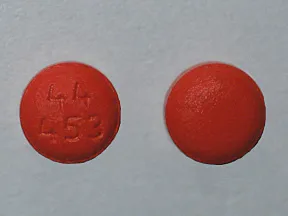 | |
| Nasal Four nasal - | 1 % liquid |  | |
| Sinus PE Decongestant oral - | 10 mg tablet |  | |
| Ephrine nasal - | 1 % drops |  | |
| Nasal Decongestant (phenylephrine) oral - | 10 mg tablet |  | |
| Neo-Synephrine (phenylephrine) nasal - | 1 % liquid | 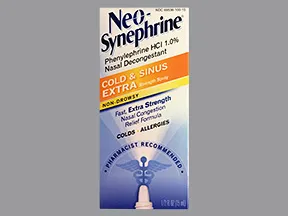 | |
| Neo-Synephrine (phenylephrine) nasal - | 1 % liquid | 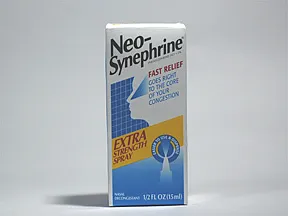 | |
| phenylephrine injection - | 10 mg/mL vial |  | |
| phenylephrine injection - | 10 mg/mL vial |  | |
| phenylephrine injection - | 10 mg/mL vial |  | |
| phenylephrine injection - | 10 mg/mL vial | 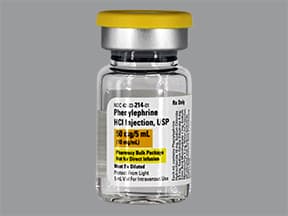 | |
| phenylephrine injection - | 10 mg/mL vial |  | |
| phenylephrine injection - | 10 mg/mL vial |  | |
| phenylephrine injection - | 10 mg/mL vial |  | |
| phenylephrine injection - | 10 mg/mL vial |  | |
| phenylephrine injection - | 10 mg/mL vial |  | |
| phenylephrine injection - | 10 mg/mL vial |  | |
| phenylephrine injection - | 10 mg/mL vial |  | |
| phenylephrine injection - | 10 mg/mL vial |  | |
| phenylephrine injection - | 10 mg/mL vial |  | |
| phenylephrine injection - | 10 mg/mL vial |  | |
| phenylephrine injection - | 10 mg/mL vial |  | |
| phenylephrine injection - | 10 mg/mL vial |  | |
| phenylephrine injection - | 10 mg/mL vial |  | |
| phenylephrine injection - | 10 mg/mL vial |  | |
| phenylephrine injection - | 10 mg/mL vial |  | |
| phenylephrine injection - | 10 mg/mL vial |  | |
| phenylephrine injection - | 10 mg/mL vial |  | |
| phenylephrine injection - | 10 mg/mL vial |  | |
| phenylephrine injection - | 10 mg/mL vial |  | |
| phenylephrine injection - | 10 mg/mL vial |  | |
| phenylephrine injection - | 10 mg/mL vial |  | |
| 4 Way nasal - | 1 % liquid |  | |
| Vazculep injection - | 10 mg/mL vial |  | |
| Vazculep injection - | 10 mg/mL vial |  | |
| Vazculep injection - | 10 mg/mL vial |  | |
| Vazculep injection - | 10 mg/mL vial |  | |
| Vazculep injection - | 10 mg/mL vial |  | |
| Wal-Four nasal - | 1 % liquid |  | |
| Wal-Four nasal - | 1 % liquid |  | |
| phenylephrine ophthalmic (eye) - | 10 % drops |  | |
| phenylephrine ophthalmic (eye) - | 2.5 % drops | 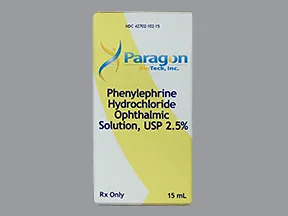 | |
| phenylephrine ophthalmic (eye) - | 2.5 % drops | 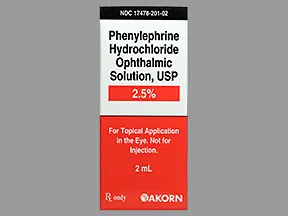 | |
| phenylephrine ophthalmic (eye) - | 10 % drops | 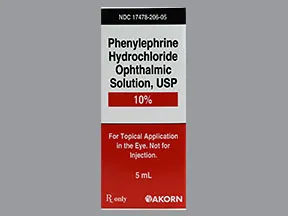 | |
| phenylephrine ophthalmic (eye) - | 2.5 % drops |  | |
| Sinus Decongestant (PE) oral - | 10 mg tablet |  | |
| Sinus Decongestant (PE) oral - | 10 mg tablet |  | |
| Sinus Decongestant (PE) oral - | 10 mg tablet |  |
Copyright © 2010 First DataBank, Inc.
Patient Handout
phenylephrine injection
NO MONOGRAPH AVAILABLE AT THIS TIME
USES: Consult your pharmacist.
HOW TO USE: Consult your pharmacist.
SIDE EFFECTS: Consult your pharmacist.In the US -Call your doctor for medical advice about side effects. You may report side effects to FDA at 1-800-FDA-1088 or at www.fda.gov/medwatch.In Canada - Call your doctor for medical advice about side effects. You may report side effects to Health Canada at 1-866-234-2345.
PRECAUTIONS: Consult your pharmacist.
DRUG INTERACTIONS: Consult your pharmacist.Keep a list of all your medications with you, and share the list with your doctor and pharmacist.
OVERDOSE: If someone has overdosed and has serious symptoms such as passing out or trouble breathing, call 911. Otherwise, call a poison control center right away. US residents can call their local poison control center at 1-800-222-1222. Canada residents can call a provincial poison control center.
NOTES: No monograph available at this time.
MISSED DOSE: Consult your pharmacist.
STORAGE: Consult your pharmacist.Do not flush medications down the toilet or pour them into a drain unless instructed to do so. Properly discard this product when it is expired or no longer needed. Consult your pharmacist or local waste disposal company for more details about how to safely discard your product.
Information last revised July 2016. Copyright(c) 2024 First Databank, Inc.
IMPORTANT: HOW TO USE THIS INFORMATION: This is a summary and does NOT have all possible information about this product. This information does not assure that this product is safe, effective, or appropriate for you. This information is not individual medical advice and does not substitute for the advice of your health care professional. Always ask your health care professional for complete information about this product and your specific health needs.
Formulary
Adding plans allows you to compare formulary status to other drugs in the same class.
To view formulary information first create a list of plans. Your list will be saved and can be edited at any time.
Adding plans allows you to:
- View the formulary and any restrictions for each plan.
- Manage and view all your plans together – even plans in different states.
- Compare formulary status to other drugs in the same class.
- Access your plan list on any device – mobile or desktop.





